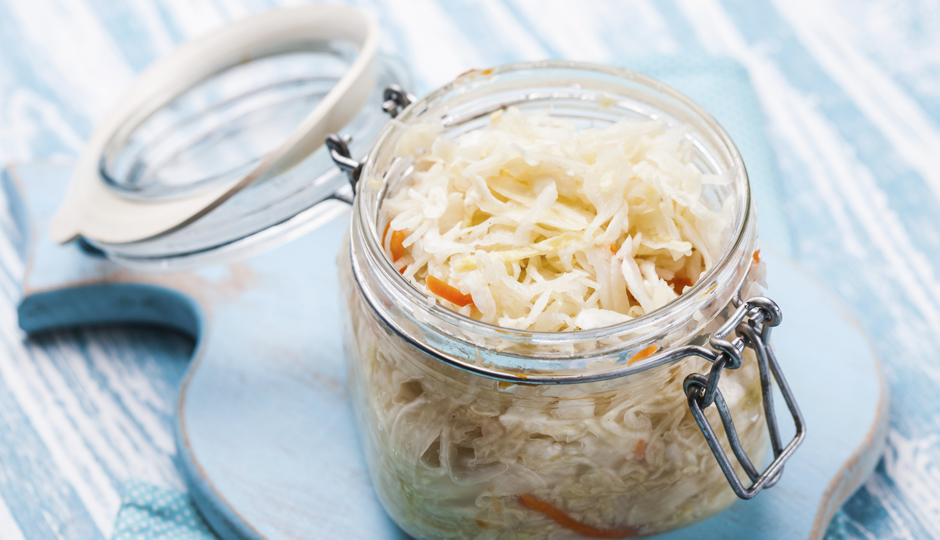My Top 5: Ways to Sneak Skin-Clearing Fermented Foods Into My Diet
Back in the winter of 2015, we chatted with Jolene Hart, Philly-based beauty and health coach and author of Eat Pretty (and the forthcoming Eat Pretty Every Day!), about the best foods to fill your plate with for glowing skin. One of the items on the list: Fermented foods.
And if you haven’t been getting your fill, you may want to start, like, now. Here’s why: Fermented foods help to build up the healthy bacteria in your gut which helps your body absorb nutrients and improves the function of your digestive system. Why does that matter? Well, as Hart tells us, “The skin is a mirror of our digestive health. The balance of good and bad ‘bugs’ in our digestive tract influences the way we react to certain foods, how well we break down and assimilate their nutrition, and how efficiently we eliminate waste. If you’re not eliminating well through your digestive tract, your skin has to pitch which can lead to blemishes or uneven skin texture.”
Crazy how everything is connected, right? But that’s not all. As Hart explains, “It’s not just our skin that’s influenced by our digestive health; our weight, moods, and immunity are all deeply impacted by the population of organisms living in and on our bodies.” This is why Hart is all about consuming some sort of probiotic-packed fermented food every day. Below, she shares her top five ways to sneak them into her diet. Take note!
1. Kraut on a salad or grain bowl. “I’m a firm believer that the dressing makes the salad. But adding a few big forkfuls of fermented sauerkraut to your regular salad or grain bowl can almost replace the need for dressing, it’s so flavor-packed. The tang, the crunch, the health benefits — you can’t go wrong. When buying fermented sauerkraut in a store, look for it in the refrigerated section (you can find it pre-made at Whole Foods, Trader Joe’s and Essene). You don’t want a pasteurized, shelf-stable product. I also feature a recipe for my favorite homemade kraut in my new book Eat Pretty Every Day.”
2. Miso as a soup or flavor enhancer. “Miso is a fermented soybean paste that is packed with beneficial bacteria. You can stir a spoonful of the paste into warm water to create instant miso soup or use it in recipes to add big flavor. Its natural sodium content means it often takes the place of salt in your cooking. Just remember not to add it to a boiling-hot dish or you will destroy much of the beneficial bacteria that it contains. Check out my Miso Broccoli Lentil Salad for a recipe that uses miso for its flavor — and digestive benefits, of course.”
3. Pickled veggies on a sandwich or burger. “Pickled vegetables (try onions, kraut, or radishes) are absolutely amazing on a sandwich or burger, so pile them on. They add crunch (way better than chips), tangy flavor, and a little saltiness from their brine. My friend Amanda Feifer’s book Ferment Your Vegetables is a must-have if you want to make your own pickled veggies at home, and her blog phickle.com has some super-easy starter recipes like these lactofermented radishes. Once you realize that you can ferment at home with as little as three ingredients (two, if you don’t count water), you’ll wonder why you waited so long to try.”
4. Leftover fermented brine in homemade salad dressing. “When you’ve eaten all of the kraut or pickled vegetables from the jar, don’t dump the brine down the drain. It’s packed with probiotics that you don’t want to miss out on. Add small amounts to dressings that you whip up at home, or even throw a shot into a smoothie. You will barely taste it and it’s fabulous for digestive health.”
5. Coconut water kefir or kombucha as a treat. “Fermented drinks like kombucha are not my favorite for every day, since they can be sugary and aren’t the best source of probiotics. But they’re refreshing as a treat and make a healthier sub for soda or even a cocktail replacement if you’re skipping alcohol. You can serve one up as a chilled, bubbly sip-in-a-wine-glass drink that feels no less festive. Cultures for Health is a great resource for the kefir grains you need to make your own fermented coconut water kefir at home.”
Like what you’re reading? Stay in touch with Be Well Philly—here’s
how:
- Like Be Well Philly on Facebook
- Follow Be Well Philly on Twitter
- Follow Be Well Philly on Pinterest
- Get the Be Well Philly Newsletter



